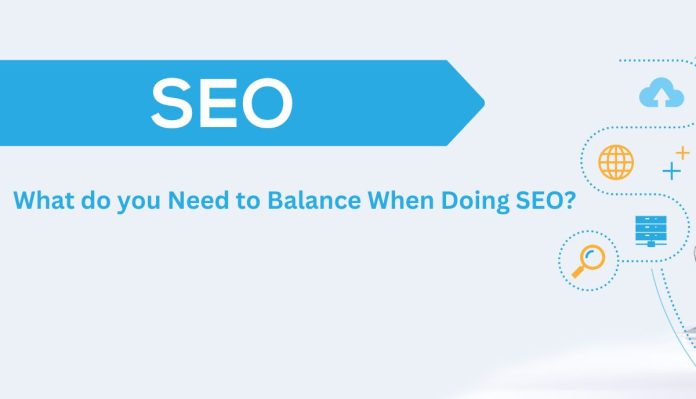One of the most popular questions people ask about search engine optimization (SEO) revolves around the idea of balance. What balance? Well, when it comes to managing and improving your site’s search rankings, it’s important to create both quality content that users are searching for and marketing efforts aimed at getting more traffic to your site in order to rank higher and/or stay on top. In this article, we’ll look at some ways you can achieve this balance as well as some examples of companies that have done so successfully.
Keyword Research
Keyword research is essential to understanding what people are looking for.
This helps determine the types of pages that should be created on your site, which keywords should be targeted, and how high in the search engine results page (SERP) your content should rank for those keywords. The more traffic a keyword brings in, the more difficult it will be for your content to rank higher than other websites who are targeting that keyword.
A low-competition keyword can be easier to rank for because there’s less competition vying for that spot. However, once you’re at the top of the SERP, it becomes even harder to stay there. You’ll also want to do some keyword research before releasing new blog posts or products so you know if they’re already being discussed online. If they are, then find a different topic! If not, then go ahead and publish!
Content Planning
When balancing SEO, there are many factors that contribute. The most important is your content’s relevance and how it ranks with the search engine. It’s best to use keywords as much as possible in your content so that it will rank higher for those terms. These are some other items that may affect a page’s ranking:
– Page loading speed – Meta tags – Keyword density – Layout structure
On Page Optimization
If your website’s on page optimization is not up to snuff, your rankings may suffer. On-page optimization includes things like keyword and content analysis, link building, and social media interaction. Many people think that all the heavy lifting for on-page optimization should be done in the early stages of a website’s creation or through blog writing, but small changes can help with on-page optimization throughout the life of a site. If you’ve been neglecting your on-page optimization up until this point, there are many ways you can get back into it! Start by making sure your keywords are varied and relevant. Include multiple links to similar pages so readers have more options for clicking away from the site if they’re not interested in what they see.
Off Page Optimization
– guest blogging on other blogs and linking back to your site
– developing relationships with influencers who have strong social media followings and asking them for a shout out
– writing articles for other websites, referencing your own content
The next step in off page optimization is getting social shares, which can be achieved through: – building a following on social media or paid advertising campaigns – posting about trending topics that are relevant to your business, and tagging people who might share it
Meta descriptions
You want your site to rank for the keywords people are searching for, but you also want it to be well written and informative. For example, if someone is looking for information about how a dog house works and they search dog house, dog houses or building a dog house on Google, your page should be listed in the search engine results as one of the top three results.
When writing content, make sure that it is relevant and fresh so that readers are more likely to click through and read what you have written.
Test, Test, and Test Again
It’s not enough just to run a couple of tests and call it a day. You should test, test, and then test again. Otherwise, you won’t know if your marketing efforts are paying off. Google changes their algorithms all the time, so it’s important to monitor how they affect your site’s rank in SERPs.
You can use free tools like Moz Toolbar and Ahrefs Site Explorer to help with this process by tracking keyword rankings and how often your website is being mentioned online. Keep an eye on what people are saying about your business online, as well.
Analyze Data Regularly
To maintain a healthy website, it’s essential to monitor the data collected from analytics tools. The data will tell us which parts of our site are working well and which are not performing as expected. To optimize our site, we want to focus on the pages that are not getting as much traffic as they should and improve them so that they can be seen by more people. This helps ensure that we’re offering visitors a quality experience every time they visit our site and make sure we’re not wasting resources on pages that don’t need work.
Stay Updated with Google Updates (Hummingbird etc.)
It’s important that you measure your results regularly and continuously improve. If not, there are three things to consider:
1) You’re not measuring the right metrics.
2) Your competition is moving forward faster than you are.
3) You’re not executing properly. It can be difficult to stay updated with Google updates because they change so often. For example, if you want a company page for your company Facebook Page on Facebook Business Manager and yet don’t have a business page on Facebook at all yet, then it will show up as pending in Facebook Business Manager. Don’t let this happen – make sure you have a business page ready before adding it in!
If an update or new algorithm was released just yesterday but no one has mentioned it since then, then maybe it wasn’t as big of an update as we thought? The rule of thumb is to wait a week or two after something major happens before trying any new strategies or tactics.
Measure Results Regularly and Continuously Improve
The best way to measure and improve your SEO is with a process that is ongoing and continuous. You should examine how your rankings are changing over time, identify those pages that are not performing well, and take action. A good way to get started with this process is by identifying the keywords that bring traffic to your site. One free tool that can help you track these keywords is Moz’s keyword explorer tool.
Final thought
The more targeted your content is, the easier it will be for people to find what they’re looking for. This can be done by ensuring that your website and social media accounts are updated often, and with content relevant to the needs of your audience. As well as having a variety of topics on your site, adding value and enriching information is important in order to help visitors stay on your site for longer periods of time. And finally, keep in mind that everyone has different search intent. When optimizing for SERP’s make sure that you’re also optimizing for conversions, which means prioritizing click-throughs from searches with high conversion rates over those with low conversion rates.

